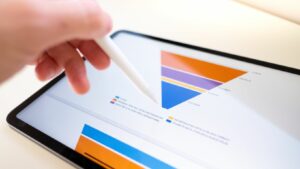Diving into the vast sea of data, one needs a reliable compass to navigate. That’s where descriptive data analysis comes in, serving as a guiding light in the murky waters of raw information. It’s not just about numbers and figures, it’s about painting a vivid picture that makes sense.
Descriptive data analysis is the first, yet critical step in the data analysis process. It’s the method that helps in summarizing, organizing, and simplifying complex data sets. But why is it so important, and how does it unlock the true value of data? Let’s delve into the fascinating world of descriptive data analysis and unravel its mysteries.
Descriptive data analysis represents the cornerstone of any exploratory investigation pursuing data comprehensibility. Extending beyond elementary summarization, it elucidates data, manifesting its true essence through a series of analytical techniques.
Descriptive Data Analysis
 The echelon of descriptive statistics commands an imperative role within the universe of data analysis. It formulates the crux of data interpretation, illustrating a clear image of gathered data through calculated summaries. For example, basic descriptive statistics – the mean, median, and mode- encapsulate data into understandable quantities while measures of dispersion- such as standard deviation, variance, and range- express data spread and identify outliers.
The echelon of descriptive statistics commands an imperative role within the universe of data analysis. It formulates the crux of data interpretation, illustrating a clear image of gathered data through calculated summaries. For example, basic descriptive statistics – the mean, median, and mode- encapsulate data into understandable quantities while measures of dispersion- such as standard deviation, variance, and range- express data spread and identify outliers.
Descriptive statistics operate under the mantle of knowledge extraction, distilling vast volumes of data into digestible nuggets. They are beneficial in diverse sectors, proliferating efficiency in decision-making. In business, aggregated summaries like sales trends, customer demographics aid in planning strategies. In the healthcare sector, statistics about patients’ conditions assist in providing specialized care.
Key Techniques in Descriptive Analysis
 Under the compartment of descriptive analysis, a multitude of techniques coexist, each with a determinant role. Computer-aided visualization techniques, statistical figures, and frequency distributions prove advantageous in drawing the panoramic image of data.
Under the compartment of descriptive analysis, a multitude of techniques coexist, each with a determinant role. Computer-aided visualization techniques, statistical figures, and frequency distributions prove advantageous in drawing the panoramic image of data.
- Graphical Displays: Diagrams and charts such as bar graphs, histograms, pie charts, and scatter plots serve as pivotal tools, giving a visual interpretation of data.
- Central Tendency Measures: Numeric values like mean, median, and mode ascertain the central point around which data points cluster.
- Dispersion Measures: Concepts such as range, variance, and standard deviation measure data diversity, denoting the dispersion of data points from the central tendency.
These techniques empower organizations and researchers, delivering a precise understanding of data, ensuring guided actions and informed decisions. Specifically, data visualization can help avoid misconceptions, creating a vivid mental image of the data’s nature, while central tendencies offer knowledge about the most common data patterns.
Tools and Software for Descriptive Data Analysis
 Truth lies in data. Yet, unveiling it necessitates proper tools and software. This section delves into some widely-used software packages and advanced analytical tools, prevalent in the realm of descriptive data analysis.
Truth lies in data. Yet, unveiling it necessitates proper tools and software. This section delves into some widely-used software packages and advanced analytical tools, prevalent in the realm of descriptive data analysis.
Excel, the champion of spreadsheets, merits the first mention. Data analysts across sectors embrace it due to its user-friendly interface and numerous mathematical functions that aid computations.
Next up, R and Python sit in the elite cadre of programming languages cherished by statisticians and data scientists. R is a boon for statistical analysis with its exhaustive catalogue of packages and visualizing tools. Python, revered for its simplified syntax, harbors various libraries like Pandas and Matplotlib pivotal for data manipulation and visualization respectively.
When to Choose Advanced Analytical Tools
Advanced analytical tools enter the picture when complexity outpaces the capacities of conventional software. For instance, machine learning algorithms, a staple of AI, decipher complex patterns impossible for traditional analytical tools. Specifically, unsupervised learning methods like clustering and association rules uncover subtle patterns and latent associations in data.
Big data technologies such as Hadoop and Spark also shine in massive data sets which conventional tools struggle to grapple with. Hadoop, with its distributed storage and processing framework, handles gargantuan data with finesse. Spark, on the other hand, is optimized for machine learning tasks and provides nimble data processing.
The choice of these advanced tools, after a point, is contingent on the data complexity and the desired depth of analysis. Comprehending both the capabilities of these tools and the demands of the data effectively empowers analysts to make felicitous tool selections.

